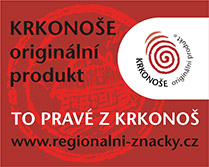The Krkonoše Mountains National Park
KRNAP – KPN these are the official abbreviations of both national parks that together cover an area of about 425 km2 (KRNAP 370 and KPN 55). In 1986 the buffer zone of an additional 184 km2 of area around the Park of the Krkonoše Mts. was declared. The Administrations of both national parks with their seats in Vrchlabí and Jelenia Góra-Sobieszów were authorized to take over the responsibility for the fate of the wildlife and landscape in the Krkonoše Mts.
Unfortunately, even the strictest and highest statute of landscape conservation - the national park - has not preserved the Krkonoše Mts. from adverse civilization pressure during the last 30 years and more. Their oustanding natural attractiveness, easy accessibility and good facilities for tourism and recreation have been reflected in a great number of visitors coming to this small range of mountains. Annually over 10 million people pass through the combined Czech and Polish sides of the Krkonoše Mts. Thus they belong to group a of the most visited national parks in the world (to their relatively small area). For this they unfortunately pay a cruel tax. The high number of their visitors and the unmastered conception of tourism have left their fatal trails on the sensitive ecosystems; - trampled paths and earth erosion, damaged flora, tons of collecting waste products of all kinds, noise and emissions of transport means, excess of buildings and building sites and the damage of the traditional local color of the mountain landscape.
Tourism, together with the whole European problem of the last few decades - industrial emissions (the consequence of which the whole areas of the Krkonoše forests have been wasting and dying since the end of the 1970s) are two limiting factors for the survival of the Krkonoše Mts. in the future. Due to the extremely big danger to the natural substance of the mountains themselves the Krkonoše Mts. were registered in the list of the most endangered national parks of the world (IUCN, 1984).
Despite the present quite unpleasing condition of the Krkonoše Mts. and of the serious socioeconomical problems of this mountain region, or even possibly therefore, they seem to be extraordinary suitable to become an example of how to solve the problem of conservation in a national park which has found itself at the breaking point of an ecologic disaster. The Krkonoše Mts. have a very good international reputation. Their recent classification in the world network of about 300 UNESCO Biosphere Reserves (1992), and the big interest of some international institutions in helping to preserve the Krkonoše Mts. (e.g. the project of the Netherland foundation FACE for the preservation and restoration of the Krkonoše forests, the World Bank project for the preservation of the biodiversity of the Krkonoše Mts. and others) are clear evidence of this reputation.
In spite of the existing problems with excesses of visitors in the Krkonoše Mts. it is evident that tourism is the only one potential source of prosperity for the local inhabitants who have been permanently living in the area of the national park or in its closest neighborhood. Well planned tourism can become the source of possible jobs for the local residents, can stimulate the local economy, foreign exchange, the improvement of the recreation facilities, and it can give life to regional cultural traditions. Thus the conditions for stimulating the interest of local people, autonomies and authorities to join the conservation of the wildlife and landscape of the national park are ripe for exploitation because only a preserved nature is a guarantee of prosperity for this region. The existence of the national park should become an advantage in economic development for local inhabitants rather than an obstacle. A lot of foreign national parks, for example Bavarian Forest NP, are evidence of the fact that such relations can be developed and that they work.The national park is then a real source for lasting useful development across an even broader region. Of course, this hinges upon the condition that we would solve the essential problem of where the limit is between a sustainable or a destructive development. Furthermore, we need to assess the carrying capacity of this very sensitive mountain area and work out a realistic management plan of permanently sustainable tourism. The Administrations of both national parks have been co-working intensively on this problem for the existence of the Krkonoše Mts.













